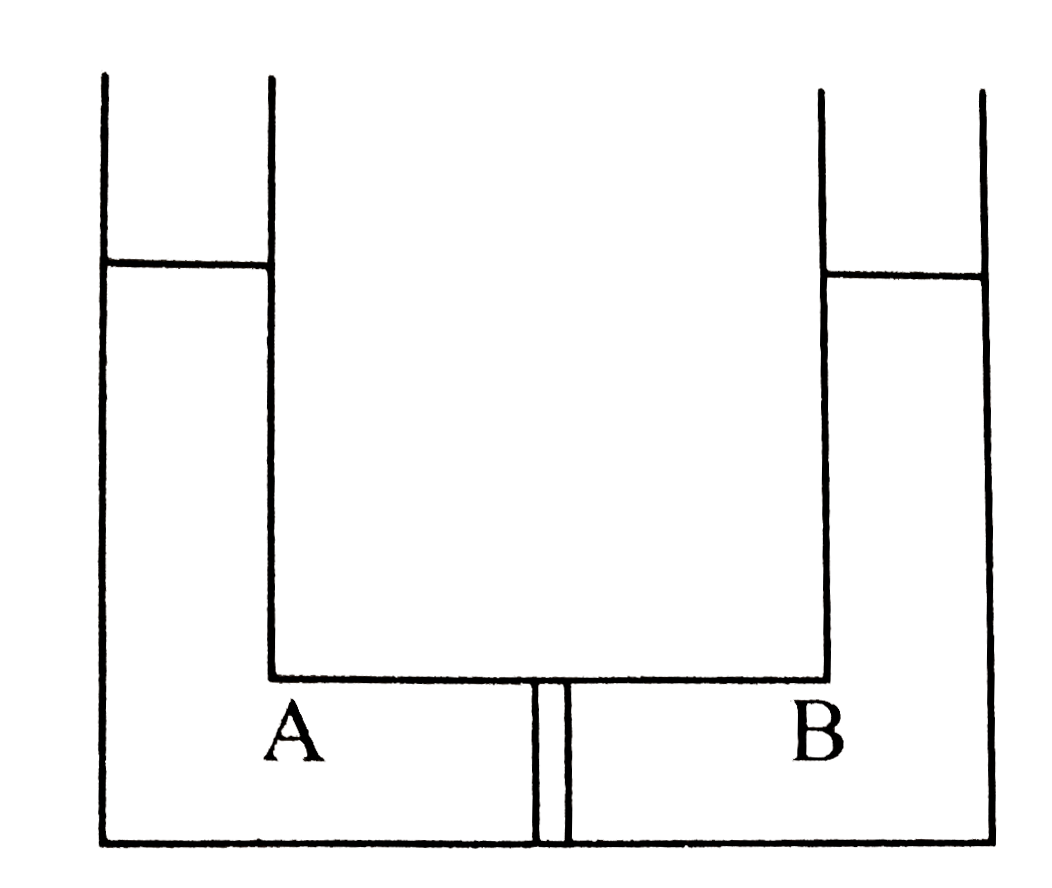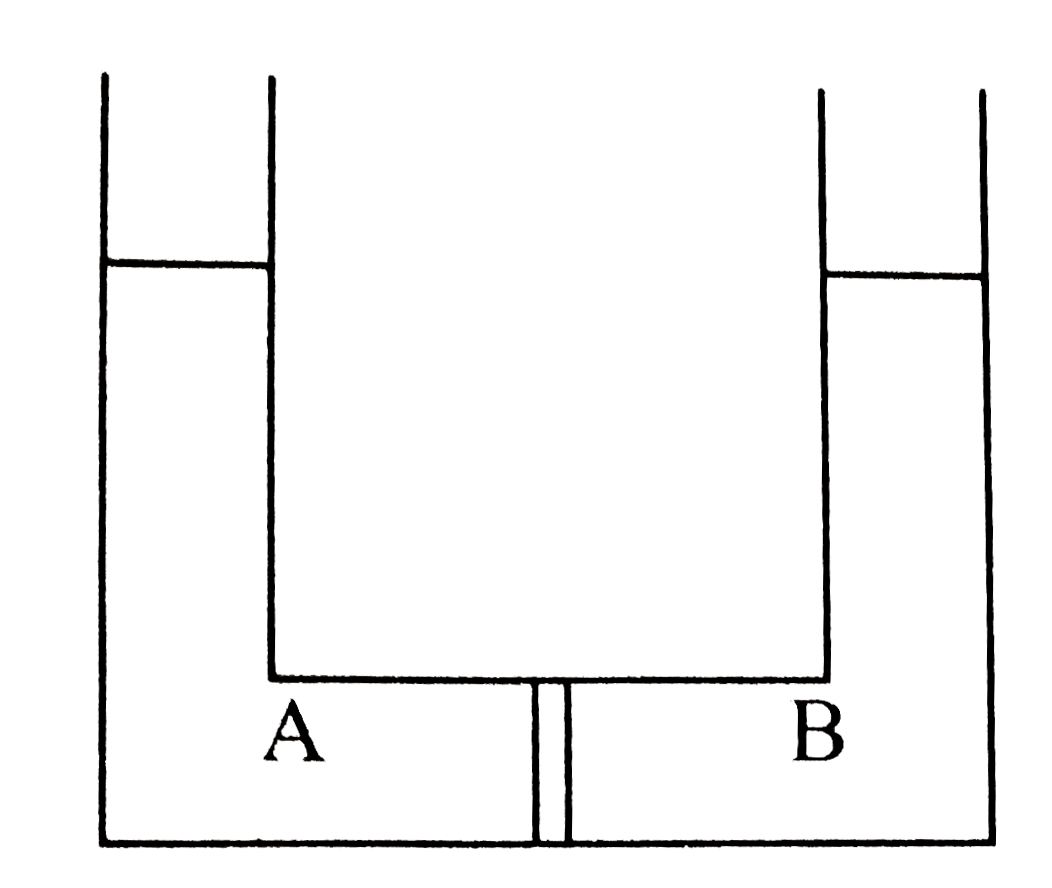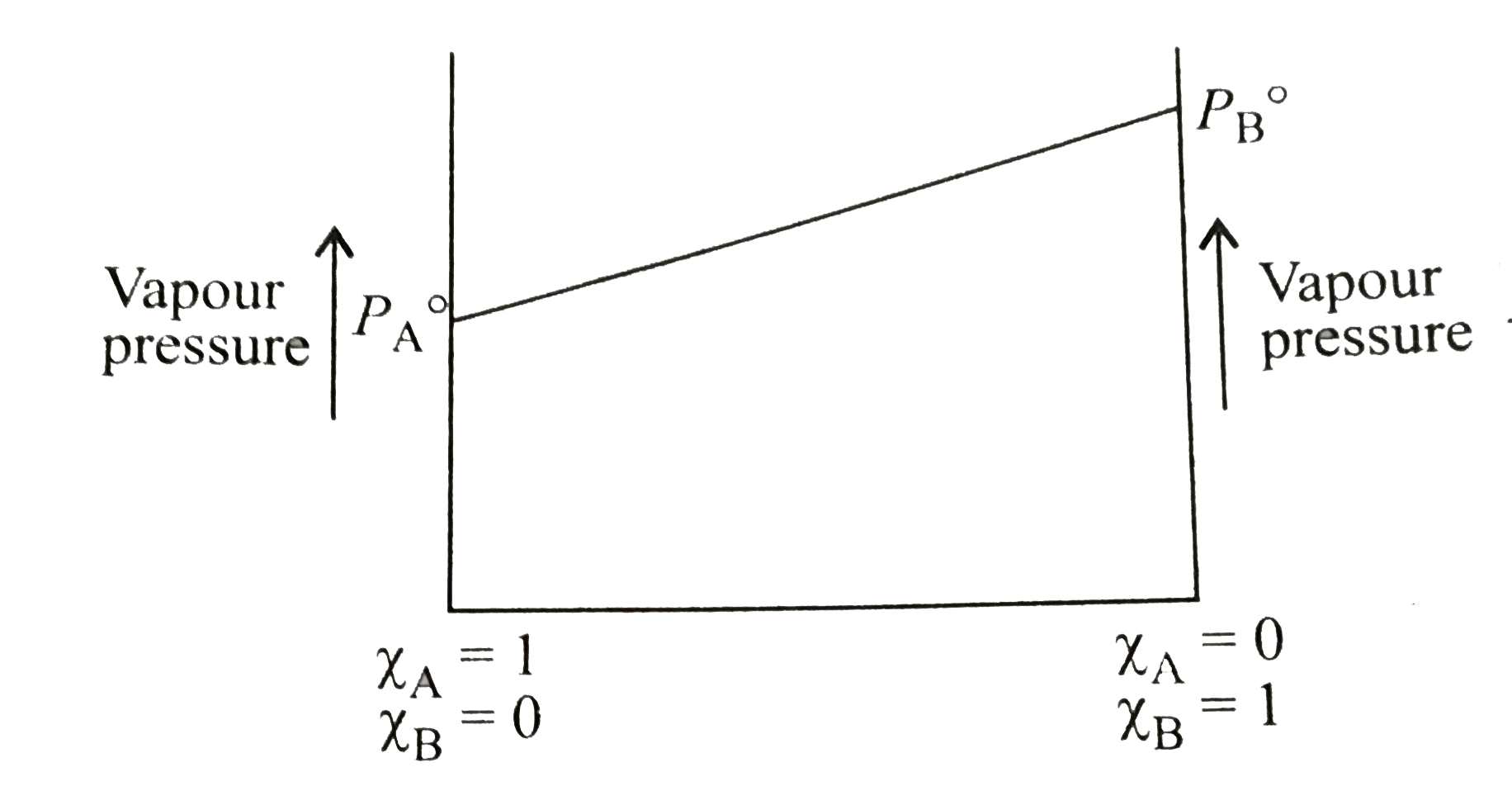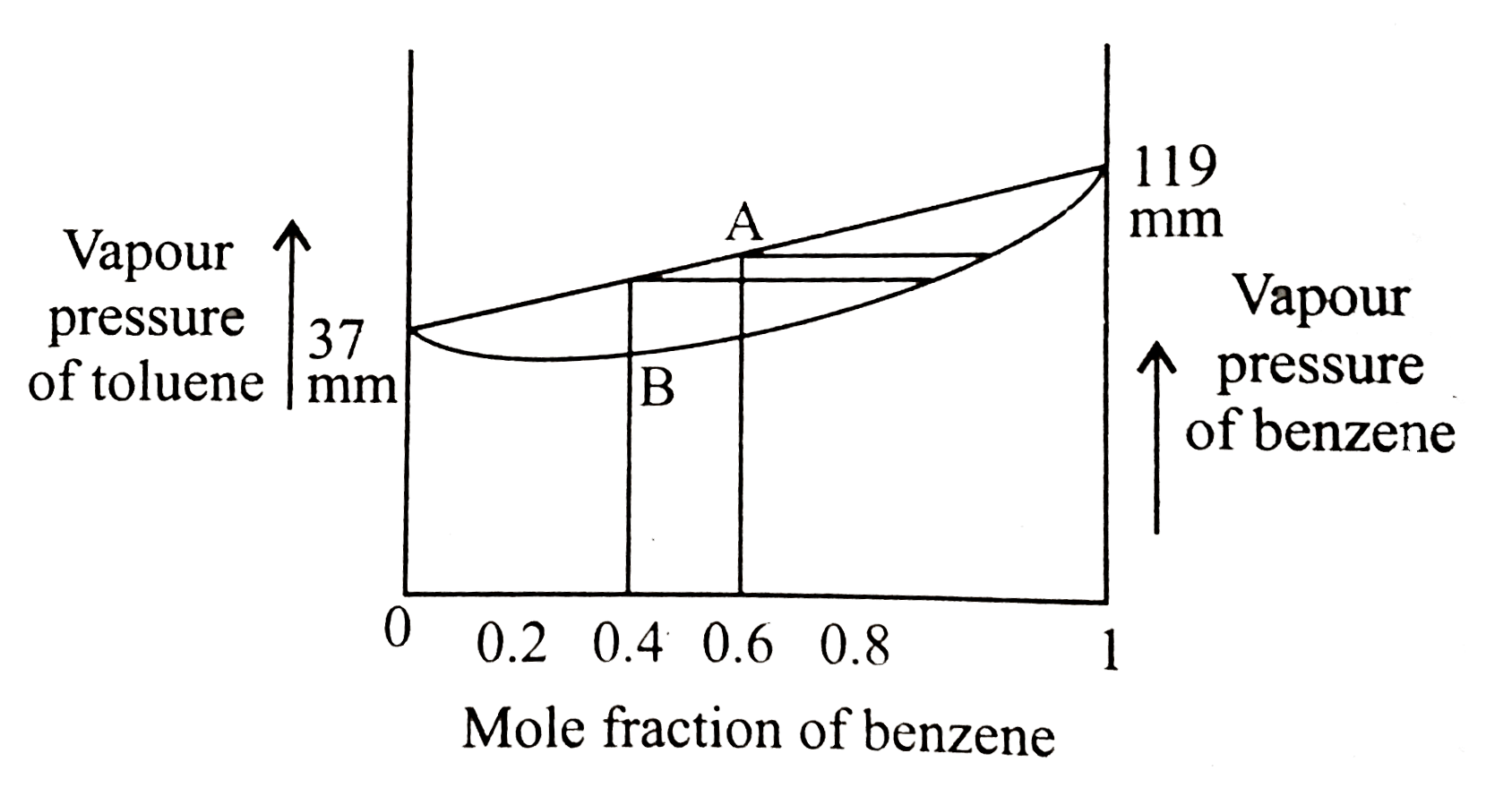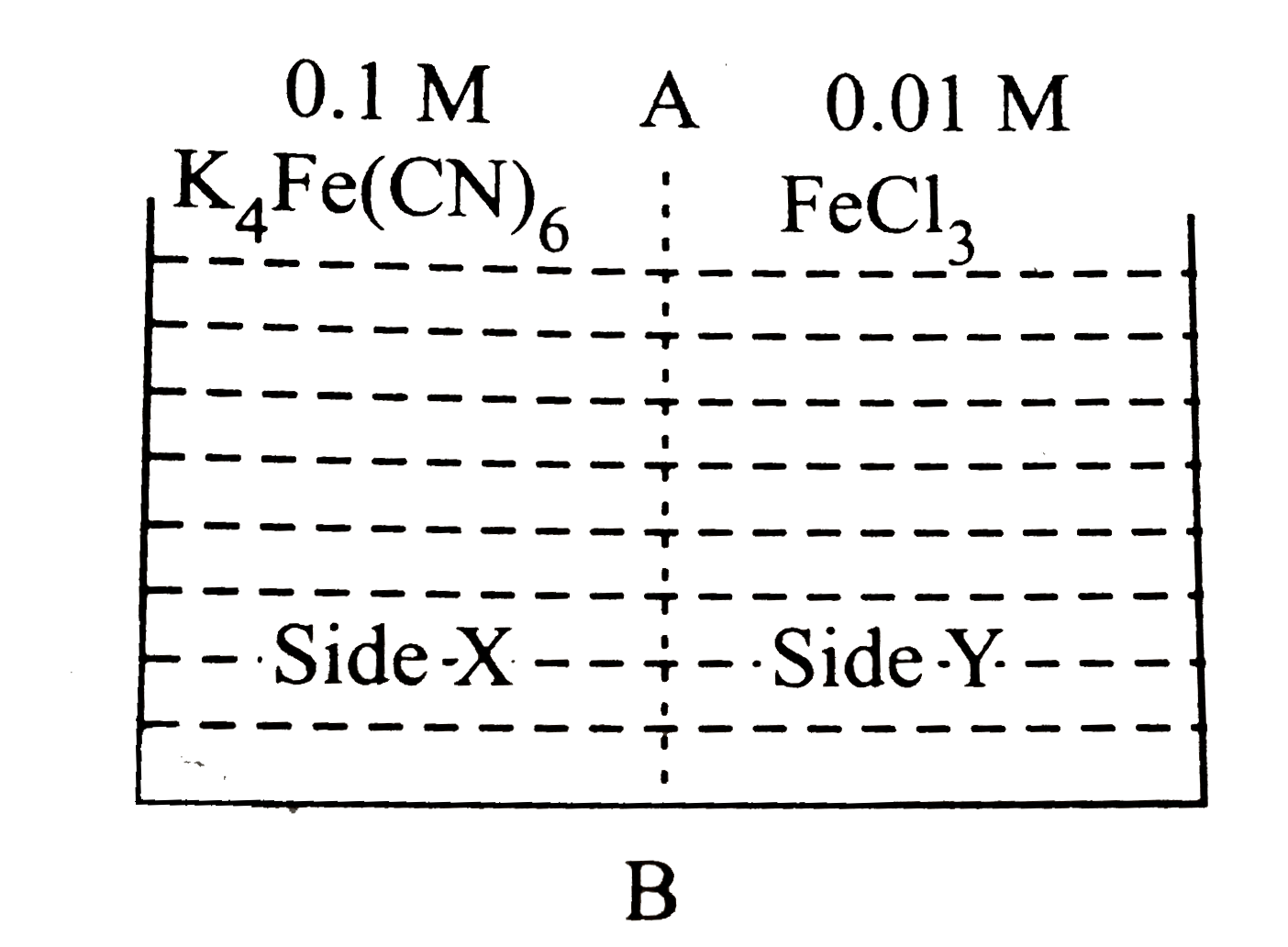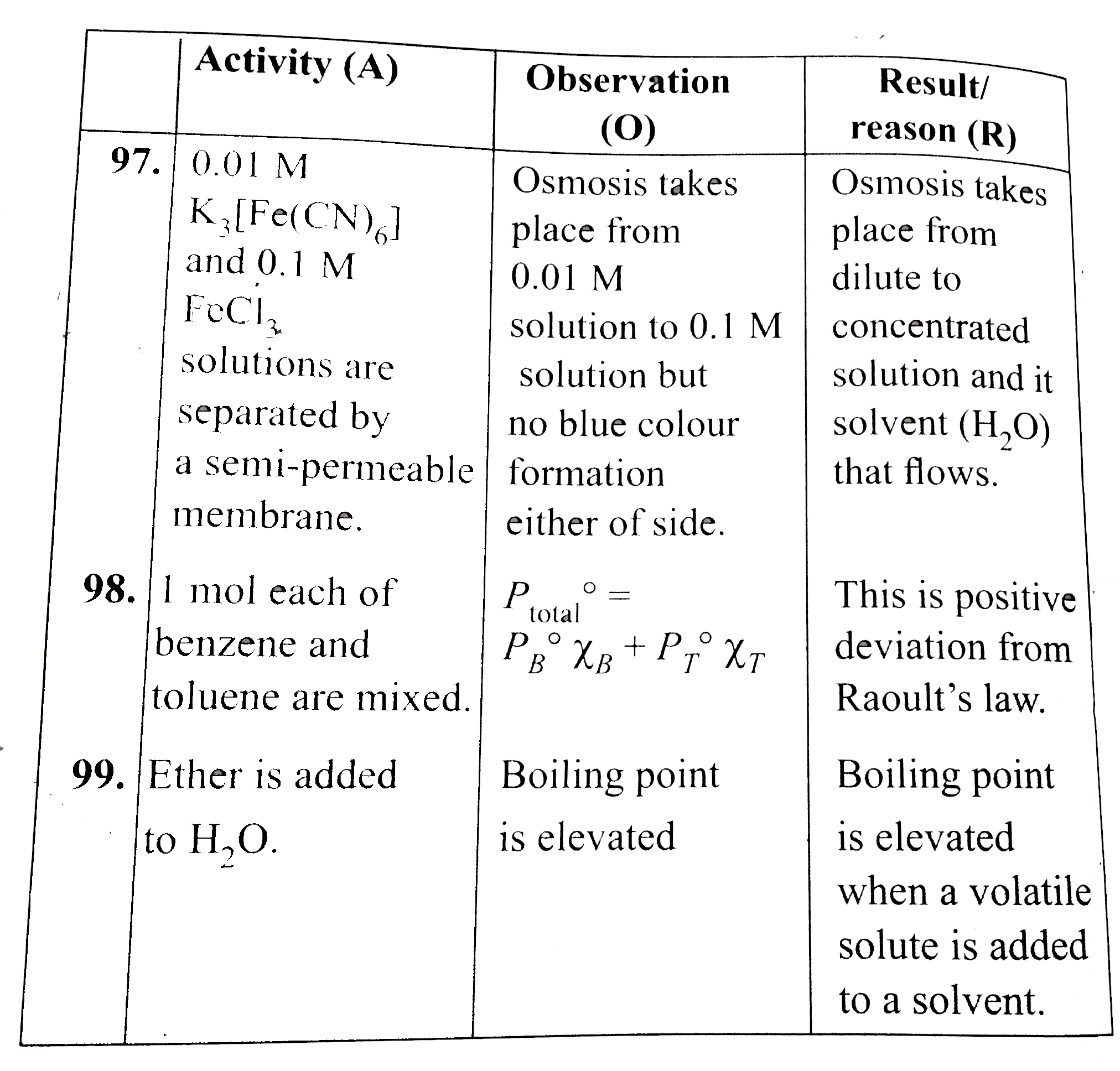Exercises (Linked Comprehension) from CENGAGE CHEMISTRY (ENGLISH) SOLUTIONS for Class 12
| Class 12 | CHEMISTRY |
| Chapter | SOLUTIONS |
| CENGAGE CHEMISTRY (ENGLISH) | Exercises (Linked Comprehension) |
| Medium | English |
| Academic Year | 2023-2024 |
Question 9
The osomotic pressure π depends on the molar concentration of the solution (π=CRT). If two solutions are of equal solute concentration and, hence, have the same omotic pressure, they are said to be isotonic. If two solutions are of unequal osmotic pressures, the more concentrated solution is said to be hypertonic and the more diluted solution is described as hypotonic.
Osmosis is the major mechanism for transporting water upward in the plants. Answer the following questions:
A plant cell shrinks when it is kept in: View SolutionQuestion 10
The osomotic pressure π depends on the molar concentration of the solution (π=CRT). If two solutions are of equal solute concentration and, hence, have the same omotic pressure, they are said to be isotonic. If two solutions are of unequal osmotic pressures, the more concentrated solution is said to be hypertonic and the more diluted solution is described as hypotonic.
Osmosis is the major mechanism for transporting water upward in the plants. Answer the following questions:
What would be the percent strength of solution of urea that would be isotonic with 4.5% solution of glucose?View SolutionQuestion 11
The osomotic pressure π depends on the molar concentration of the solution (π=CRT). If two solutions are of equal solute concentration and, hence, have the same omotic pressure, they are said to be isotonic. If two solutions are of unequal osmotic pressures, the more concentrated solution is said to be hypertonic and the more diluted solution is described as hypotonic.
Osmosis is the major mechanism for transporting water upward in the plants. Answer the following questions:
The glucose solution to be injected into the bloodstream and the blood itself should have the same.View SolutionQuestion 12
The osomotic pressure π depends on the molar concentration of the solution (π=CRT). If two solutions are of equal solute concentration and, hence, have the same omotic pressure, they are said to be isotonic. If two solutions are of unequal osmotic pressures, the more concentrated solution is said to be hypertonic and the more diluted solution is described as hypotonic.
Osmosis is the major mechanism for transporting water upward in the plants. Answer the following questions:
Isotonic solutions have same View SolutionQuestion 13
The osomotic pressure π depends on the molar concentration of the solution (π=CRT). If two solutions are of equal solute concentration and, hence, have the same omotic pressure, they are said to be isotonic. If two solutions are of unequal osmotic pressures, the more concentrated solution is said to be hypertonic and the more diluted solution is described as hypotonic.
Osmosis is the major mechanism for transporting water upward in the plants. Answer the following questions:
Osmotic rise of a solution depends on View SolutionQuestion 14
The solution which boil at constant temperature like a pure liquid and possess same composition in liquid as well as vapour state are called azeotropes. The components of azetropes cannot be separated by fractional distillation. Only non-ideal solutions form azeotropes. Solutions with negative deviation form maximum boiling azeotrope and the solutions with positive deviation form minimum boiling azeotrope. The boiling point of an azeotrope is never equal to the boiling points of any of the components of the azeotrope.
Answer the following question:
The azeotropic solutions of two miscible liquids View SolutionQuestion 15
The solution which boil at constant temperature like a pure liquid and possess same composition in liquid as well as vapour state are called azeotropes. The components of azetropes cannot be separated by fractional distillation. Only non-ideal solutions form azeotropes. Solutions with negative deviation form maximum boiling azeotrope and the solutions with positive deviation form minimum boiling azeotrope. The boiling point of an azeotrope is never equal to the boiling points of any of the components of the azeotrope.
Answer the following question:
The azeotropic solutions of two miscible liquids
Solutions which distill without any change in composition or temperature are calledView SolutionQuestion 16
The solution which boil at constant temperature like a pure liquid and possess same composition in liquid as well as vapour state are called azeotropes. The components of azetropes cannot be separated by fractional distillation. Only non-ideal solutions form azeotropes. Solutions with negative deviation form maximum boiling azeotrope and the solutions with positive deviation form minimum boiling azeotrope. The boiling point of an azeotrope is never equal to the boiling points of any of the components of the azeotrope.
Answer the following question:
The azeotropic solutions of two miscible liquids
The azeotropic mixture of water and HCl boils at 108.5∘C. This solution is View SolutionQuestion 17
The solution which boil at constant temperature like a pure liquid and possess same composition in liquid as well as vapour state are called azeotropes. The components of azetropes cannot be separated by fractional distillation. Only non-ideal solutions form azeotropes. Solutions with negative deviation form maximum boiling azeotrope and the solutions with positive deviation form minimum boiling azeotrope. The boiling point of an azeotrope is never equal to the boiling points of any of the components of the azeotrope.
Answer the following question:
The azeotropic solutions of two miscible liquids
100mL of liquid A and 50mL of liquid B are mixed to form 138mL solution. It is View SolutionQuestion 18
The solution which boil at constant temperature like a pure liquid and possess same composition in liquid as well as vapour state are called azeotropes. The components of azetropes cannot be separated by fractional distillation. Only non-ideal solutions form azeotropes. Solutions with negative deviation form maximum boiling azeotrope and the solutions with positive deviation form minimum boiling azeotrope. The boiling point of an azeotrope is never equal to the boiling points of any of the components of the azeotrope.
Answer the following question:
The azeotropic solutions of two miscible liquids
Which among the following combinations is a maximum boiling azeotrope?View SolutionQuestion 24
The electrolyte solutions show abnormal colligative porperties.To account for this effect we define a quantity called the Van't Hoff factor given by
i=Actual number of particles in solution after dissociationNumber of formula units initially dissolved in solution
i=1(for non-electrolytes)
i>1(for electrolytes, undergoing dissociation)
i<1(for solutes, undergoing association)
Answer the following questions:
Benzoic acid undergoes dimerization in bezene solution. The Van't Hoff factor i for the solutions is View SolutionQuestion 25
The electrolyte solutions show abnormal colligative porperties.To account for this effect we define a quantity called the Van't Hoff factor given by
i=Actual number of particles in solution after dissociationNumber of formula units initially dissolved in solution
i=1(for non-electrolytes)
i>1(for electrolytes, undergoing dissociation)
i<1(for solutes, undergoing association)
Answer the following questions:
certain substances trimerize when dissolved in a solvent A. The Van't Hoff factor i for the solutions isView SolutionQuestion 26
The electrolyte solutions show abnormal colligative porperties.To account for this effect we define a quantity called the Van't Hoff factor given by
i=Actual number of particles in solution after dissociationNumber of formula units initially dissolved in solution
i=1(for non-electrolytes)
i>1(for electrolytes, undergoing dissociation)
i<1(for solutes, undergoing association)
Answer the following questions:
For a solution of a non-electrolyte in water, the Van't Hoff factor is View SolutionQuestion 27
The electrolyte solutions show abnormal colligative porperties.To account for this effect we define a quantity called the Van't Hoff factor given by
i=Actual number of particles in solution after dissociationNumber of formula units initially dissolved in solution
i=1(for non-electrolytes)
i>1(for electrolytes, undergoing dissociation)
i<1(for solutes, undergoing association)
Answer the following questions:
0.1MK4[Fe(CN)6] is 60% ionized. What will be its Van't Hoff factor?View SolutionQuestion 28
The electrolyte solutions show abnormal colligative porperties.To account for this effect we define a quantity called the Van't Hoff factor given by
i=Actual number of particles in solution after dissociationNumber of formula units initially dissolved in solution
i=1(for non-electrolytes)
i>1(for electrolytes, undergoing dissociation)
i<1(for solutes, undergoing association)
Answer the following questions:
A solution of benzoic acid is dissolved in benzene such that it undergoes molecular association and its molar mass apporaches 244. The benzoic molecules will exist as View SolutionQuestion 32
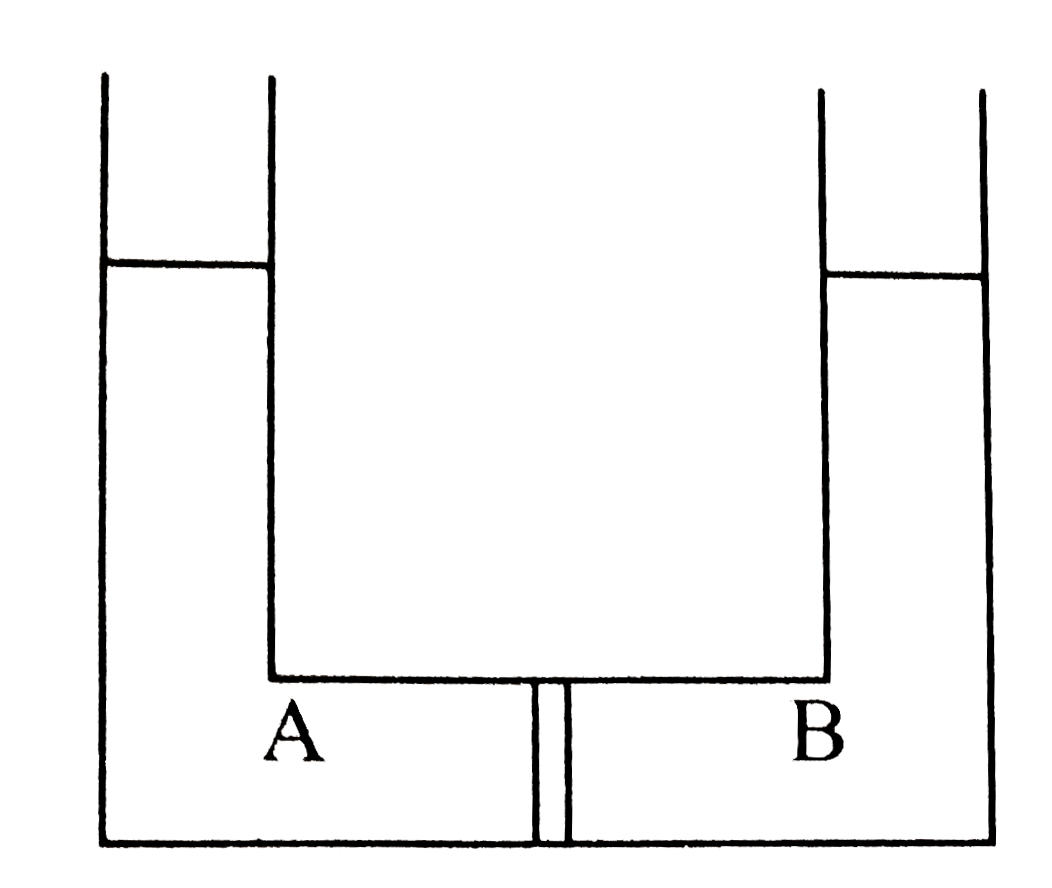
Compartment A and B have the following combinations of solution:
AB10.1MKCl0.2MKCl20.1%(m/V)NaCl10%(m/V)NaCl318gL−1glucose34.2gL−1sucrose420%(m/V)glucose10%(m/V)glucose
Indicate the solution(s) in which compartment B will show an increases in volume.
1) 1,2,4
2) 1,2
3) 2,3
4) 3,4View SolutionQuestion 34
The boiling point elevation and freezing point depression of solutions have a number of partical applications. Ethylene glycol (CH2OH−CH2OH) is used in automobile radiatiors as an antifreeze because it lowers the freezing point of the coolant. The same substance also helps to prevent the radiator coolant from boiling away by elevating the boiling point. Ethylene glycol has low vapour pressure. We can also use glycerol as an antifreeze. In order for the boiling point elevation to occur, the solute must be non-volatile, but no such restriction applies to freezing point depression. For example, methanol (CH3OH), a fairly volatile liquid that boils only at 65∘C, is sometimes used as an antifreeze in automobile radiators.
Which of the following is a better reagent for depression in freezing point but not for elevation in boiling point?View SolutionQuestion 35
The boiling point elevation and freezing point depression of solutions have a number of partical applications. Ethylene glycol (CH_(2)OH-CH_(2)OH) is used in automobile radiatiors as an antifreeze because it lowers the freezing point of the coolant. The same substance also helps to prevent the radiator coolant from boiling away by elevating the boiling point. Ethylene glycol has low vapour pressure. We can also use glycerol as an antifreeze. In order for the boiling point elevation to occur, the solute must be non-volatile, but no such restriction applies to freezing point depression. For example, methanol (CH_(3)OH), a fairly volatile liquid that boils only at 65^(@)C, is sometimes used as an antifreeze in automobile radiators.
124g each of the two reagents glycol and glycerol are added in 5kg of water of the radiators in two cars. Which of the following statements is wrong?
(a)Both will act as antifreeze.
(b)Glycol will be better.
(c)Glycerol is better because its molar mass is greater than glycol.
(d)all of these View SolutionQuestion 36
The boiling point elevation and freezing point depression of solutions have a number of partical applications. Ethylene glycol (CH2OH−CH2OH) is used in automobile radiatiors as an antifreeze because it lowers the freezing point of the coolant. The same substance also helps to prevent the radiator coolant from boiling away by elevating the boiling point. Ethylene glycol has low vapour pressure. We can also use glycerol as an antifreeze. In order for the boiling point elevation to occur, the solute must be non-volatile, but no such restriction applies to freezing point depression. For example, methanol (CH3OH), a fairly volatile liquid that boils only at 65∘C, is sometimes used as an antifreeze in automobile radiators.
620g glycol is added to 4kg water in the radiator of car. What amount of ice will separate out at −6∘C?View SolutionQuestion 37
The boiling point elevation and freezing point depression of solutions have a number of partical applications. Ethylene glycol (CH2OH−CH2OH) is used in automobile radiatiors as an antifreeze because it lowers the freezing point of the coolant. The same substance also helps to prevent the radiator coolant from boiling away by elevating the boiling point. Ethylene glycol has low vapour pressure. We can also use glycerol as an antifreeze. In order for the boiling point elevation to occur, the solute must be non-volatile, but no such restriction applies to freezing point depression. For example, methanol (CH3OH), a fairly volatile liquid that boils only at 65∘C, is sometimes used as an antifreeze in automobile radiators.
If the cost of glycerol, glycol, and methanol is same, then the sequence of economy to use these compounds as antifreeze will be View SolutionQuestion 38
The boiling point elevation and freezing point depression of solutions have a number of partical applications. Ethylene glycol (CH2OH−CH2OH) is used in automobile radiatiors as an antifreeze because it lowers the freezing point of the coolant. The same substance also helps to prevent the radiator coolant from boiling away by elevating the boiling point. Ethylene glycol has low vapour pressure. We can also use glycerol as an antifreeze. In order for the boiling point elevation to occur, the solute must be non-volatile, but no such restriction applies to freezing point depression. For example, methanol (CH3OH), a fairly volatile liquid that boils only at 65∘C, is sometimes used as an antifreeze in automobile radiators.
Which among the following is the most volatile and the best antifreeze?View SolutionQuestion 39
Properties such as boiling point, freezing point, and vapour pressure of a pure solvent change when solute molecules are added to get homogeneous solution. These are called colligative properties. Applications of colligative properties are very useful in day-tөday life. One of the examples is the use of the mixture of ethylene glycol and water as an anti-freezing liquid in the radiator of automobiles. A solution M is prepared by mixing ethanol and water. The mole fraction of ethanol in the mixture is 0.9.
Given: Freezing point depression constant of water
Kwaterf=1.86Kkgmol−1
Freezing point depression constant of ethanol
Kethanolf=2.0Kkgmol−1
Boiling point elevation constant of water
Kwaterb=2.52Kkgmol−1
Boiling point elevation constant of ethanol
Kethanolb=1.2Kkgmol−1
Standard freezing point of water = 273K
Standard freezing point of ethanol = 155.7K
Standard boiling point of water = 373K
Standard boiling point of ethanol = 315.5K
Vapour pressure of pure water =32.8mmHg
Vapour pressure of pure ethanol=40mmHg
Molecular weight of water =18gmol−1
Molecular weight of ethanol =46gmol−1
In answering the following questions, consider the solutions to be ideal dilute solutions and solutes to be non-volatile and non-dissociative.
The freezing point of solution M is View SolutionQuestion 40
Properties such as boiling point, freezing point, and vapour pressure of a pure solvent change when solute molecules are added to get homogeneous solution. These are called colligative properties. Applications of colligative properties are very useful in day-tөday life. One of the examples is the use of the mixture of ethylene glycol and water as an anti-freezing liquid in the radiator of automobiles. A solution M is prepared by mixing ethanol and water. The mole fraction of ethanol in the mixture is 0.9.
Given: Freezing point depression constant of water
Kwaterf=1.86Kkgmol−1
Freezing point depression constant of ethanol
Kethanolf=2.0Kkgmol−1
Boiling point elevation constant of water
Kwaterb=2.52Kkgmol−1
Boiling point elevation constant of ethanol
Kethanolb=1.2Kkgmol−1
Standard freezing point of water = 273K
Standard freezing point of ethanol = 155.7K
Standard boiling point of water = 373K
Standard boiling point of ethanol = 315.5K
Vapour pressure of pure water =32.8mmHg
Vapour pressure of pure ethanol=40mmHg
Molecular weight of water =18gmol−1
Molecular weight of ethanol =46gmol−1
In answering the following questions, consider the solutions to be ideal dilute solutions and solutes to be non-volatile and non-dissociative.
The vapour pressure of solution M is View SolutionQuestion 41
Properties such as boiling point, freezing point, and vapour pressure of a pure solvent change when solute molecules are added to get homogeneous solution. These are called colligative properties. Applications of colligative properties are very useful in day-tөday life. One of the examples is the use of the mixture of ethylene glycol and water as an anti-freezing liquid in the radiator of automobiles. A solution M is prepared by mixing ethanol and water. The mole fraction of ethanol in the mixture is 0.9.
Given: Freezing point depression constant of water
Kwaterf=1.86Kkgmol−1
Freezing point depression constant of ethanol
Kethanolf=2.0Kkgmol−1
Boiling point elevation constant of water
Kwaterb=2.52Kkgmol−1
Boiling point elevation constant of ethanol
Kethanolb=1.2Kkgmol−1
Standard freezing point of water = 273K
Standard freezing point of ethanol = 155.7K
Standard boiling point of water = 373K
Standard boiling point of ethanol = 315.5K
Vapour pressure of pure water =32.8mmHg
Vapour pressure of pure ethanol=40mmHg
Molecular weight of water =18gmol−1
Molecular weight of ethanol =46gmol−1
In answering the following questions, consider the solutions to be ideal dilute solutions and solutes to be non-volatile and non-dissociative.
The freezing point of solution M is View SolutionQuestion 42
Properties such as boiling point, freezing point, and vapour pressure of a pure solvent change when solute molecules are added to get homogenous solution. These are called colligative properties.
Anwer the following questions:
i.0.001mNaCl
ii.0.001 m urea
iii.0.001mMgCl2
iv.0.001mCH3COOH
Increasing order of boiling pointsView SolutionQuestion 43
Properties such as boiling point, freezing point, and vapour pressure of a pure solvent change when solute molecules are added to get homogenous solution. These are called colligative properties.
Anwer the following questions:
i.0.1 M ethanol
ii.0.1mBa3(PO4)3
iii.0.1mNa2SO4
Increasing order of freezing pointsView SolutionQuestion 44
Properties such as boiling point, freezing point, and vapour pressure of a pure solvent change when solute molecules are added to get homogenous solution. These are called colligative properties.
Anwer the following questions:
i.0.1 M glucose
ii.1% urea solution
iii.0.1 M common salt
Increasing order of osmotic pressure View SolutionQuestion 45
Properties such as boiling point, freezing point, and vapour pressure of a pure solvent change when solute molecules are added to get homogenous solution. These are called colligative properties.
Anwer the following questions:
i. NaNO3 ii.BaCl2
iii. K3[Fe(CN)6] iv. C6H12O6
Increasing order of Van't Hoff factorView SolutionQuestion 46
A certain vessel X has water and nitrogen gas at a total pressure of 2 atm and 300K. All the contents of vessel was transferred to another vessel Y having half the capacity of the vessel X. The pressure of N2 in this vessel was 3.8 atm at 300K. The vessel Y is heated to 320K and the total pressure observed was 4.32 atm. Assume that the volume occupied by the gases in vessel is equal to the volume of the vessel. Calculate the following:
Pressure of H2O in X at 320K.View SolutionQuestion 47
A certain vessel X has water and nitrogen gas at a total pressure of 2 atm and 300K. All the contents of vessel and transferred to another vessel Y having half the capacity of the vessel X. The pressure of N2 in this vessel was 3.8 atm at 300K. The vessel Y is heated to 320K and the total pressure observed was 4.32 atm. Assume that the volume occupied by the gases in vessel is equal to the volume of the vessel. Calculate the following:
Pressure of H2 at 320K.View SolutionQuestion 48
A certain vessel X has water and nitrogen gas at a total pressure of 2 atm and 300K. All the contents of vessel and transferred to another vessel Y having half the capacity of the vessel X. The pressure of N2 in this vessel was 3.8 atm at 300K. The vessel Y is heated to 320K and the total pressure observed was 4.32 atm. Assume that the volume occupied by the gases in vessel is equal to the volume of the vessel. Calculate the following:
Pressure of water vapour at 320K.View SolutionQuestion 49
A certain vessel X has water and nitrogen gas at a total pressure of 2 atm and 300K. All the contents of vessel and transferred to another vessel Y having half the capacity of the vessel X. The pressure of N2 in this vessel was 3.8 atm at 300K. The vessel Y is heated to 320K and the total pressure observed was 4.32 atm. Assume that the volume occupied by the gases in vessel is equal to the volume of the vessel. Calculate the following:
Enthalpy of vapourization.View SolutionQuestion 50
A system of greater disorder of molecules is more probable. The disorder of molecules is reflected by the entropy of the system. A liquid vapourizes to form a more disordered gas. When a solute is present, there is additional contribution to the entropy of the liquid due to increased randomness. As the entropy of solution is higher than that of pure liquid, there is weaker tendency to form the gas. Thus, a solute (non-volatile) lowers the vapour pressure of a liquid, and hence a higher boiling point of the solution.
Similarly, the greater randomness of the solution opposes the tendercy to freeze. In consequence, a lower temperature must be reached for achieving the equilibrium between the solid (frozen solvent) and the solution. The elevation in boiling point (ΔTb) and depression in freezing point (ΔTf) of a solution are the colligative properties which depend only on the concentration of particles of the solute and not their identity. For dilute solutions, (ΔTb) and (ΔTf) are proportional to the molarity of the solute in the solution.
Dissolution of a non-volatile solute into a liquid leads to View SolutionQuestion 51
A system of greater disorder of molecules is more probable. The disorder of molecules is reflected by the entropy of the system. A liquid vapourizes to form a more disordered gas. When a solute is present, there is additional contribution to the entropy of the liquid due to increased randomness. As the entropy of solution is higher than that of pure liquid, there is weaker tendency to form the gas. Thus, a solute (non-volatile) lowers the vapour pressure of a liquid, and hence a higher boiling point of the solution.
Similarly, the greater randomness of the solution opposes the tendercy to freeze. In consequence, a lower temperature must be reached for achieving the equilibrium between the solid (frozen solvent) and the solution. The elevation in boiling point (ΔTb) and depression in freezing point (ΔTf) of a solution are the colligative properties which depend only on the concentration of particles of the solute and not their identity. For dilute solutions, (ΔTb) and (ΔTf) are proportional to the molarity of the solute in the solution.
To aqueous solution of Nal, increasing amounts of solid Hgl2 is added. The vapour pressure of the solutionView SolutionQuestion 52
A system of greater disorder of molecules is more probable. The disorder of molecules is reflected by the entropy of the system. A liquid vapourizes to form a more disordered gas. When a solute is present, there is additional contribution to the entropy of the liquid due to increased randomness. As the entropy of solution is higher than that of pure liquid, there is weaker tendency to form the gas. Thus, a solute (non-volatile) lowers the vapour pressure of a liquid, and hence a higher boiling point of the solution.
Similarly, the greater randomness of the solution opposes the tendercy to freeze. In consequence, a lower temperature must be reached for achieving the equilibrium between the solid (frozen solvent) and the solution. The elevation in boiling point (ΔTb) and depression in freezing point (ΔTf) of a solution are the colligative properties which depend only on the concentration of particles of the solute and not their identity. For dilute solutions, (ΔTb) and (ΔTf) are proportional to the molarity of the solute in the solution.
A liquid possessing which of the following characteristics will be most suitable for determining the molecular mass of a compound by cryoscopic measurements?View SolutionQuestion 53
A system of greater disorder of molecules is more probable. The disorder of molecules is reflected by the entropy of the system. A liquid vapourizes to form a more disordered gas. When a solute is present, there is additional contribution to the entropy of the liquid due to increased randomness. As the entropy of solution is higher than that of pure liquid, there is weaker tendency to form the gas. Thus, a solute (non-volatile) lowers the vapour pressure of a liquid, and hence a higher boiling point of the solution.
Similarly, the greater randomness of the solution opposes the tendercy to freeze. In consequence, a lower temperature must be reached for achieving the equilibrium between the solid (frozen solvent) and the solution. The elevation in boiling point (ΔTb) and depression in freezing point (ΔTf) of a solution are the colligative properties which depend only on the concentration of particles of the solute and not their identity. For dilute solutions, (ΔTb) and (ΔTf) are proportional to the molarity of the solute in the solution.
A mixture of two immiscible liquids at a constant pressure of 1.0atm boils at temperatureView SolutionQuestion 54
represents the distillation of mixture of liquid A and liquid B which gives both of pure liquid A and B . Represents the azeotropic mixture of HNO3 and H2O which distillation gives an azeotropic mixture and either of pure liquid. We cannot separate both the pure liquid, i.e., H2O and HNO3.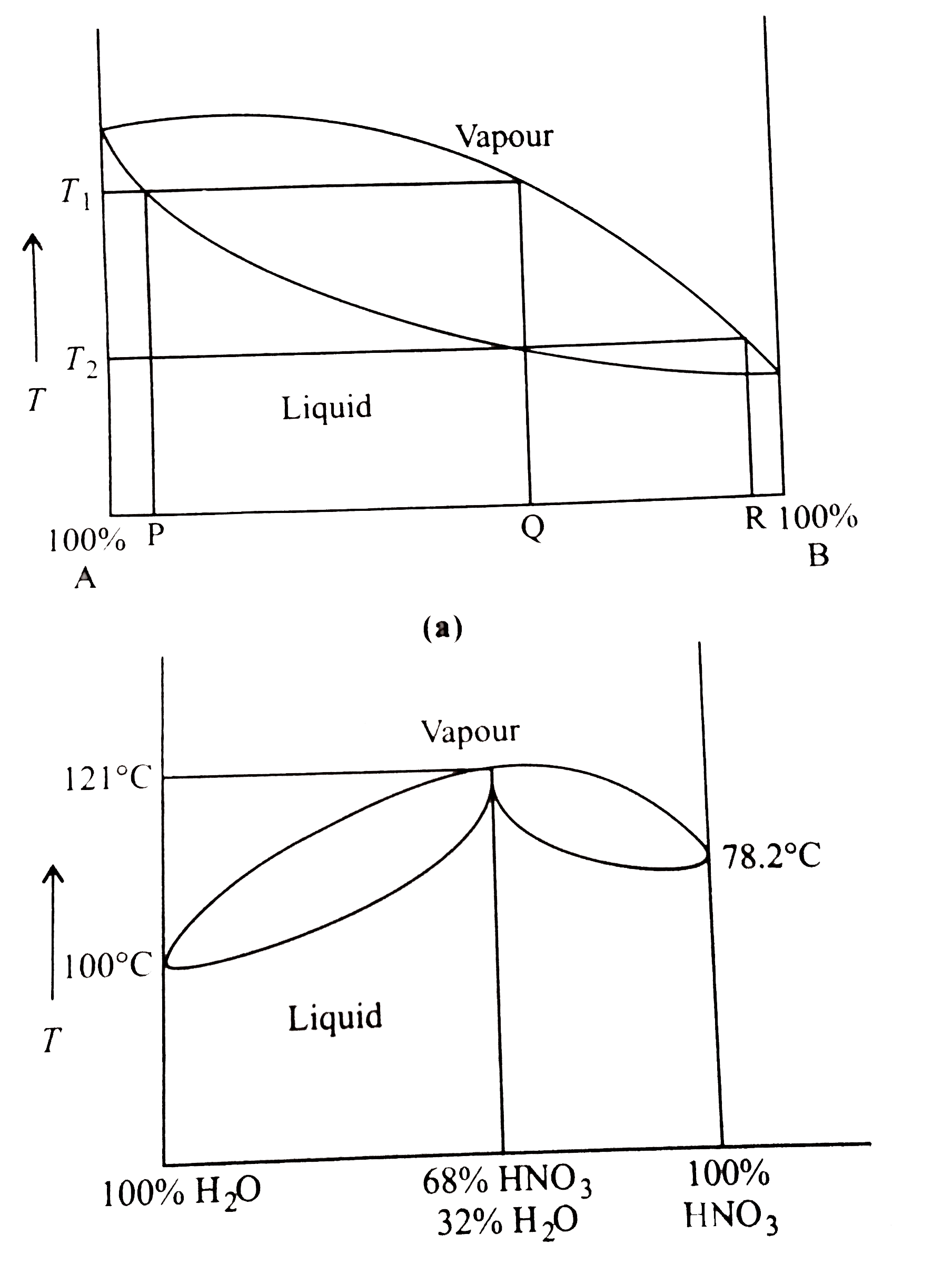
What is the result of distilling a mixture of 50%HNO3 and 50%H(2)O ?
a.Pure water and azeotropic mixtue can be separated.
b.Pure H2O and pure HNO3 can be separated.
c.Pure HNO3 and azeotropic mixture can be separated.
d.None of theseView SolutionQuestion 55
represents the distillation of mixture of liquid A and liquid B which gives both of pure liquid A and B . Represents the azeotropic mixture of HNO3 and H2O which distillation gives an azeotropic mixture and either of pure liquid. We cannot separate both the pure liquid, i.e., H2O and HNO3.
What is the result of distilling a mixture of 80%HNO3 and 20%H2O?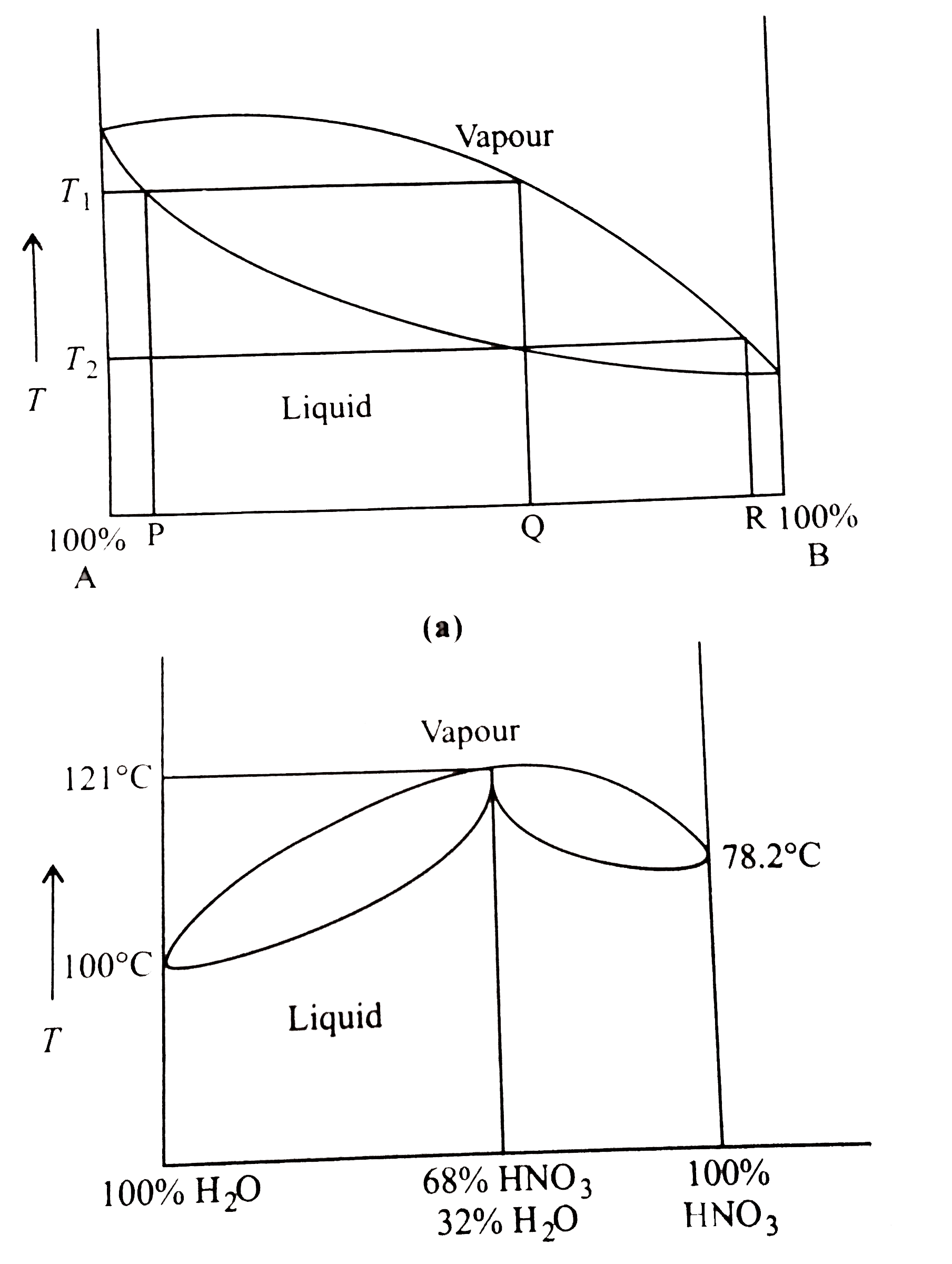
(a)Pure H2O and azeotropic mixture can be separated.
(b)Pure H2O and pure HNO3 can be separated.
(c)Pure HNO3 and azeotropic mixture can be separated.
(d)None of theseView SolutionQuestion 56
represents the distillation of mixture of liquid A and liquid B which gives both of pure liquid A and B . Represents the azeotropic mixture of HNO3 and H2O which distillation gives an azeotropic mixture and either of pure liquid. We cannot separate both the pure liquid, i.e., H2O and HNO3.
Which of the following statements is/are correct?
i. HNO3 solution is not obeying the Raoult's law.
ii. More the difference in vapour pressure of pure compounds forming a mixture, easier to separate them through distillation.
iii. T2 is less than T1 because the liquid of composition Q is richer in more volatile component.
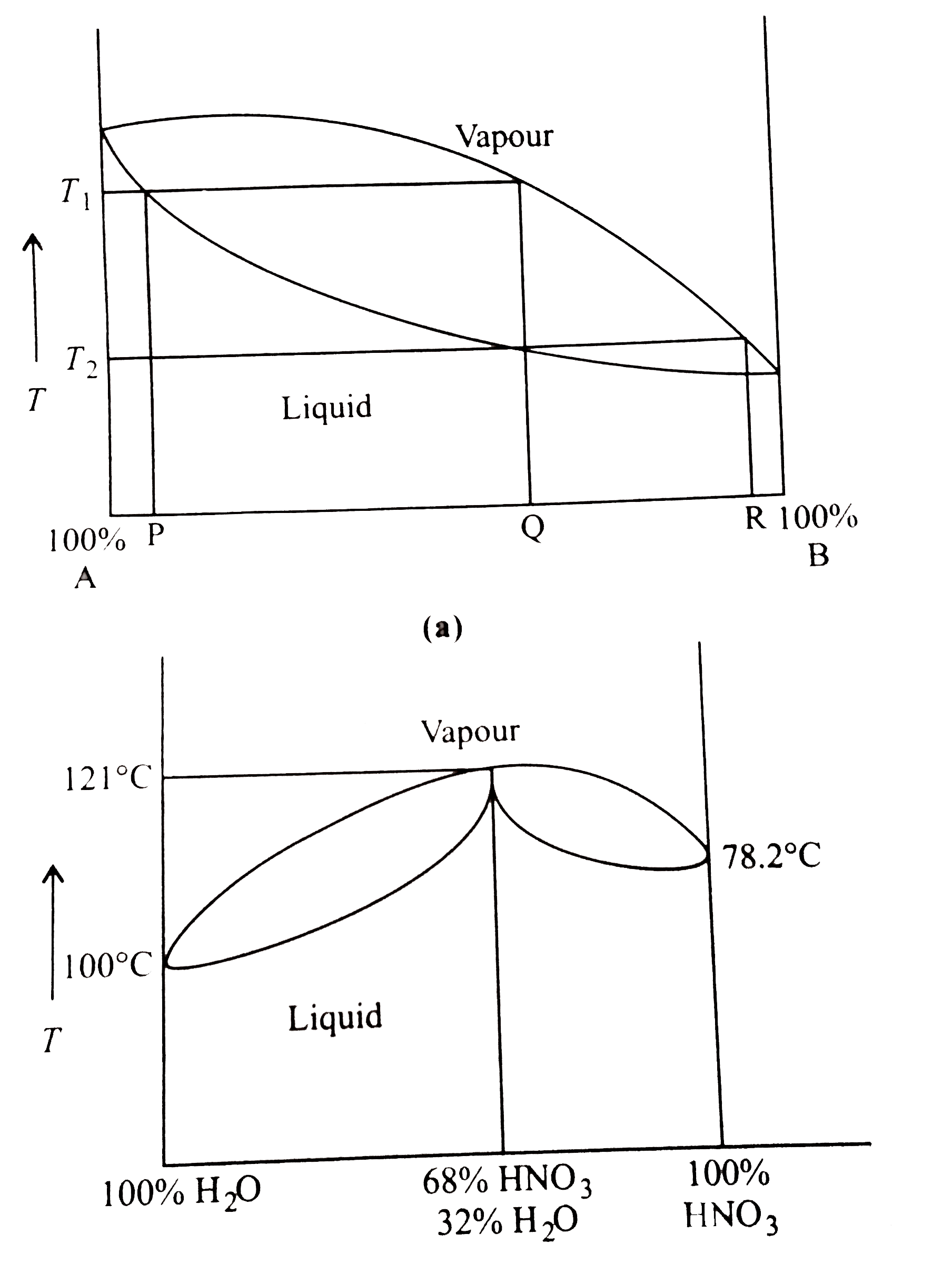 View Solution
View SolutionQuestion 57
represents the distillation of mixture of liquid A and liquid B which gives both of pure liquid A and B . Represents the azeotropic mixture of HNO3 and H2O which distillation gives an azeotropic mixture and either of pure liquid. We cannot separate both the pure liquid, i.e., H2O and HNO3.
a solution of 50% of A and 50% of B on distillation results into
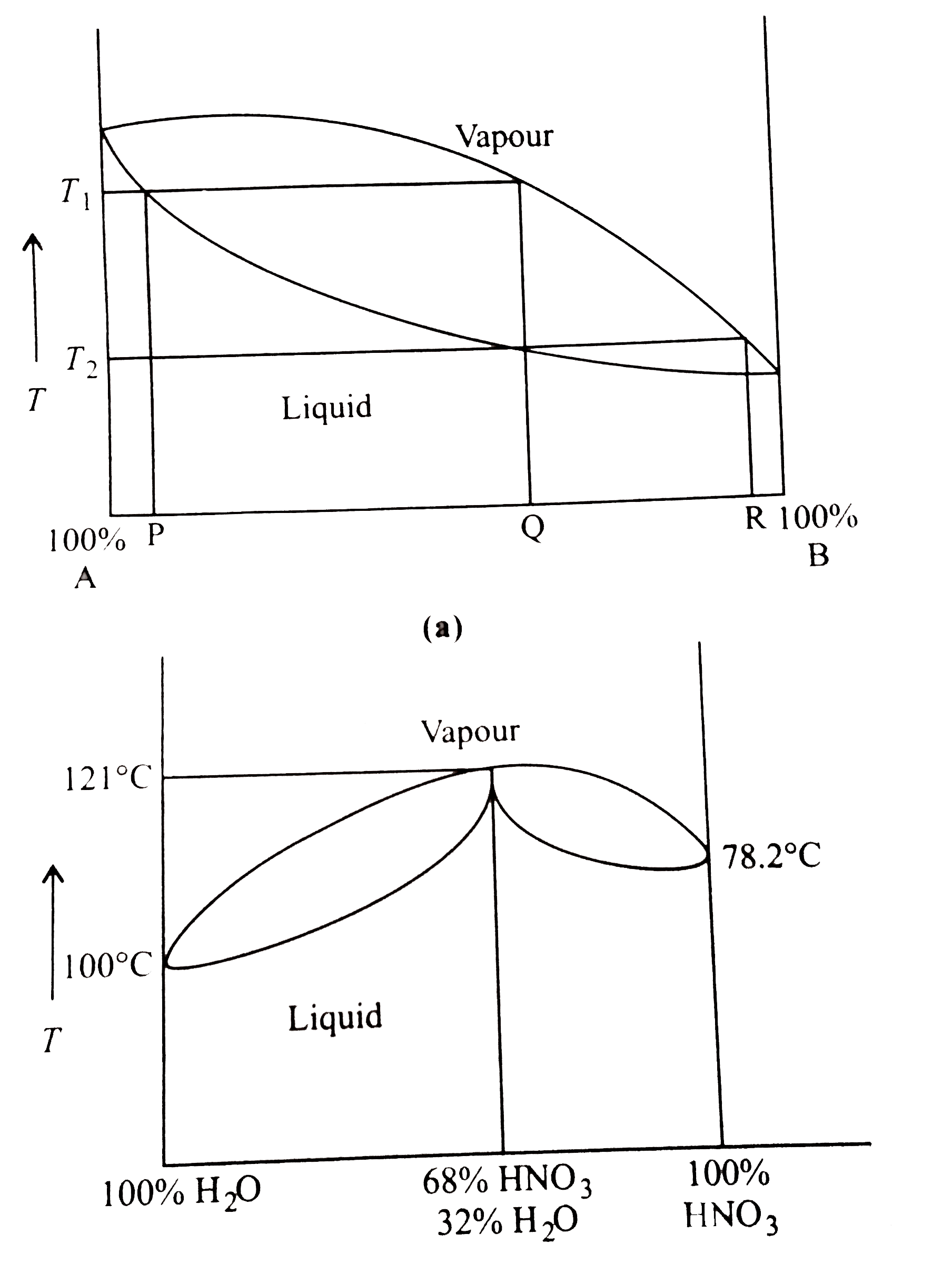
Separation of an azeotropic mixture and pure A .
Separation of an azeotropic mixture and pure B .
Separation of both pure A and pure B .
None of theseView SolutionQuestion 58
represents the distillation of mixture of liquid A and liquid B which gives both of pure liquid A and B . Represents the azeotropic mixture of HNO3 and H2O which distillation gives an azeotropic mixture and either of pure liquid. We cannot separate both the pure liquid, i.e., H2O and HNO3.
At temperature T1 and composition Q, which of the following is true?
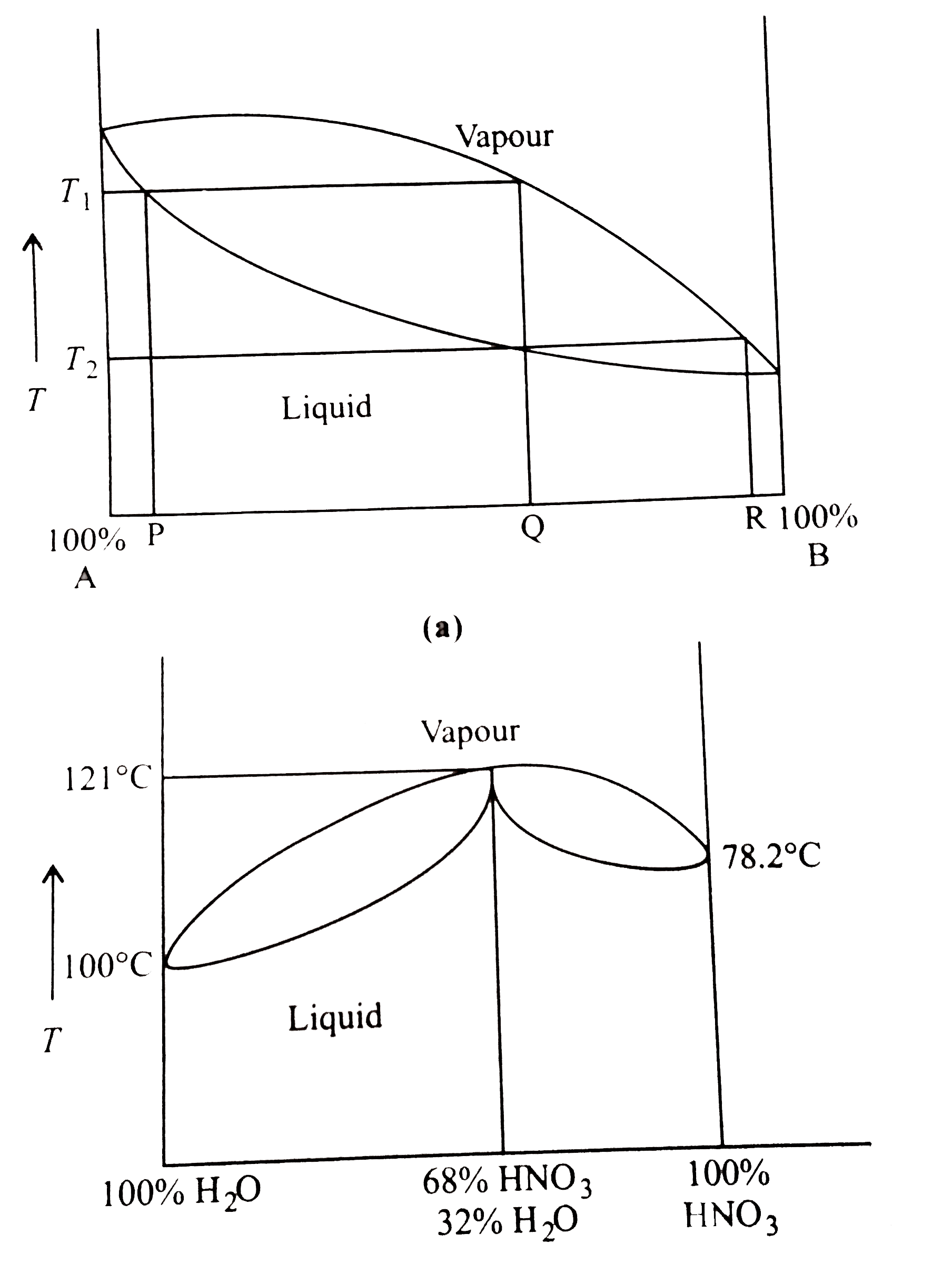
a.Vapour phase is richer in B while liquid phase is richer in A .
b.Distillation of composition Q gives only pure A .
c.Distillation of composition Q gives only pure A and pure B .
d.Distillation of composition Q gives higher percentage of B and A .View SolutionQuestion 179
Based on the given diagram, which of the following statements regarding the homogenous solution of two volatile liquids are correct? (1) Plots AD and BC show that Raoult's law is obeyed for the solution in which B is a solvent and A is the solute and as well as for that in which A is solvent and B is solute. (2) Plot CD shows that Dalton's law of partial pressures is obeyed by the binary solution of components A and B. (3) EF + EG = EH; and AC and BD correspond to the vapour pressure of the pure solvents A and B respectively.
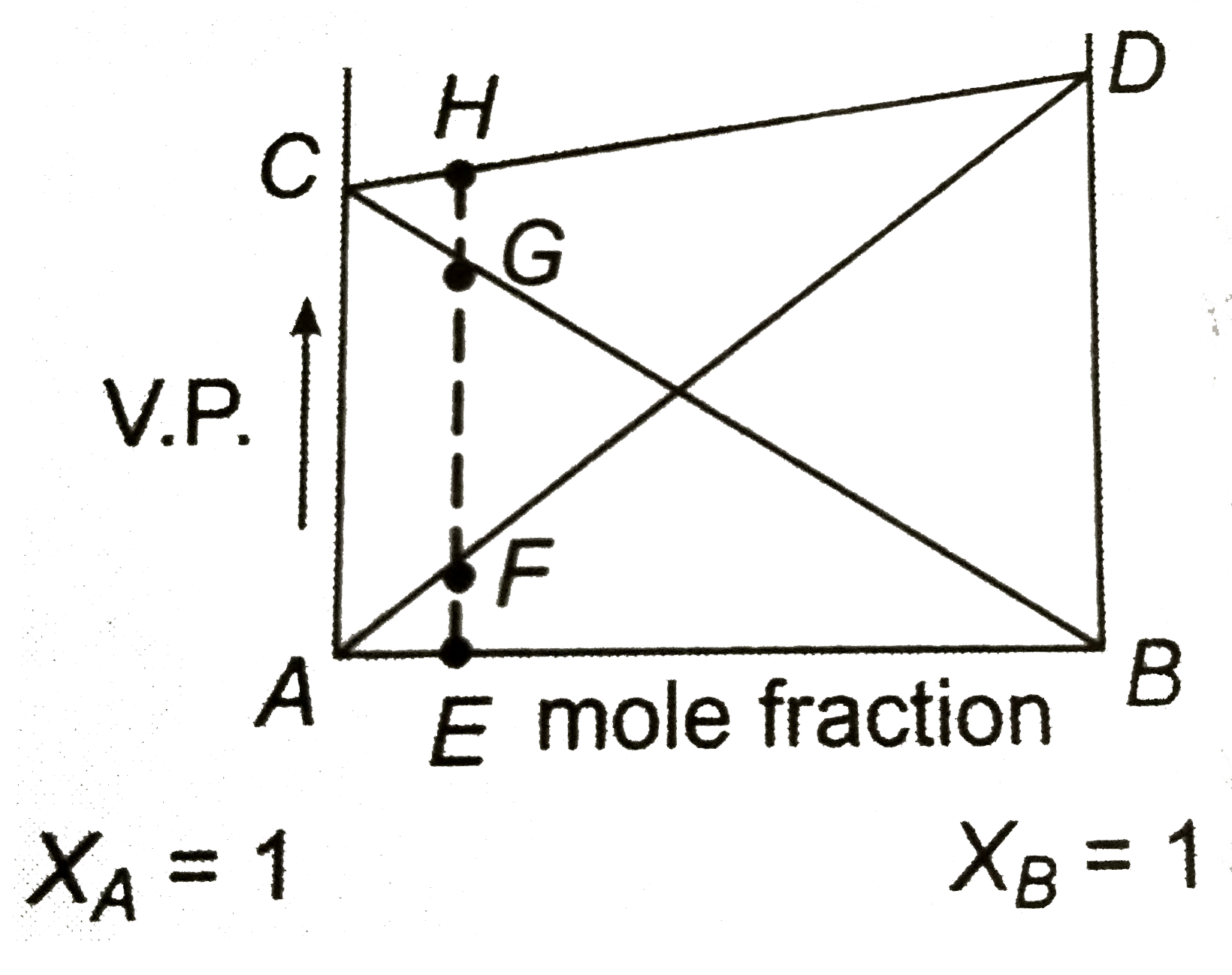 View Solution
View SolutionQuestion 247
Properties such as boiling point, freezing point and vapour pressure of a pure solvent change when solute molecules are added to get homogeneous solution. These are called colligative properties. Applications of colligative properties are very useful in day-to-day life. One of its examples is the use of ethylene glycol and water mixture as anti-freezing liquid in the radiator of automobiles.
A solution M is prepared by mixing ethanol and water. Thus moel fraction of ethanol in the mixture is 0.9.
Given: Freezing point depression constant of water
(Kwaterf)=1.86Kkgmol−1
Freezing point depression constant of ethanol
(Kethanolf)=2.0Kkgmol−1
Boiling point elevation constant of water
(Kwaterb)=0.52Kkgmol−1
Boiling point elevation constant of ethanol
(Kethanolb)=1.2Kkgmol−1
Standard freezing point of water =273K
Standard freezing point of ethanol =155.7K
Standard boiling point of water =373K
Standard boiling point of ethanol =351.5K
vapour pressure of pure water =32.8mmHg
Vapour pressure of pure ethanol =40mmHg
Molecualr weight of water =18gmol−1
Molecular weight of ethanol =46gmol−1
In asweering the following questions, consider the solutions to be ideal dilute solutions and solutes to be non-volatile and non-dissociative.
The freezing point of the solution M is :View SolutionQuestion 248
Properties such as boiling point, freezing point and vapour pressure of a pure solvent change when solute molecules are added to get homogeneous solution. These are called colligative properties. Applications of colligative properties are very useful in day-to-day life. One of its examples is the use of ethylene glycol and water mixture as anti-freezing liquid in the radiator of automobiles.
A solution M is prepared by mixing ethanol and water. Thus moel fraction of ethanol in the mixture is 0.9.
Given: Freezing point depression constant of water
(Kwaterf)=1.86Kkgmol−1
Freezing point depression constant of ethanol
(Kethanolf)=2.0Kkgmol−1
Boiling point elevation constant of water
(Kwaterb)=0.52Kkgmol−1
Boiling point elevation constant of ethanol
(Kethanolb)=1.2Kkgmol−1
Standard freezing point of water =273K
Standard freezing point of ethanol =155.7K
Standard boiling point of water =373K
Standard boiling point of ethanol =351.5K
vapour pressure of pure water =32.8mmHg
Vapour pressure of pure ethanol =40mmHg
Molecualr weight of water =18gmol−1
Molecular weight of ethanol =46gmol−1
In asweering the following questions, consider the solutions to be ideal dilute solutions and solutes to be non-volatile and non-dissociative.
The vapour pressure of the solution M is:View SolutionQuestion 249
Properties such as boiling point, freezing point, and vapour pressure of a pure solvent change when solute molecules are added to get homogeneous solution. These are called colligative properties. Applications of colligative properties are very useful in day-tөday life. One of the examples is the use of the mixture of ethylene glycol and water as an anti-freezing liquid in the radiator of automobiles. A solution M is prepared by mixing ethanol and water. The mole fraction of ethanol in the mixture is 0.9.
Given: Freezing point depression constant of water
Kwaterf=1.86Kkgmol−1
Freezing point depression constant of ethanol
Kethanolf=2.0Kkgmol−1
Boiling point elevation constant of water
Kwaterb=2.52Kkgmol−1
Boiling point elevation constant of ethanol
Kethanolb=1.2Kkgmol−1
Standard freezing point of water = 273K
Standard freezing point of ethanol = 155.7K
Standard boiling point of water = 373K
Standard boiling point of ethanol = 315.5K
Vapour pressure of pure water =32.8mmHg
Vapour pressure of pure ethanol=40mmHg
Molecular weight of water =18gmol−1
Molecular weight of ethanol =46gmol−1
In answering the following questions, consider the solutions to be ideal dilute solutions and solutes to be non-volatile and non-dissociative.
The freezing point of solution M is View SolutionQuestion 265
For a dilute solution containing 2.5g of a non-volatile non-electrolyte solution in 100g of water, the elevation in boiling point at 1 atm pressure is 2∘C. Assuming concentration of solute is much lower than the concentration of solvent, the vapour pressure (mm of Hg) of the solution is:
(take kb=0.76Kkgmol−1)View SolutionQuestion 271
Two liquids A and B form an ideal solution. At 300K, the vapour pressure of a solution containing 1mol of A and 3mol fo B is 550mmHg. At the same temperature, if 1molmore of B is added to this solution, the vapour pressure of the solution increases by 10mmHg. Determine the vapour pressure of A and B in their pure states.View SolutionQuestion 272
An organic compound CxH2yOy was burnt with twice the amount of oxygen needed for complete combustion of CO2 and H2O. The hot gases when cooled to 0∘C and 1 atm pressure, measured 2.24 L, the water collected during cooling weighed 0.9 g The vapour pressure of pure water at 20∘C is 17.5 mm Hg and is lowered by 0.104 mm when 50 g of the organic compound is dissolved in 1000 g of water. Give the molecular formula of the organic compound.View SolutionQuestion 274
The vapour pressures of ethanol and methanol are 44.5 and 88.7mmHg, respectively. An ideal solution is formed at the same temperature by mixing 60g of ethanol with 40g of methanol. Calculate the total vapour pressure of the solution and mole fraction of methanol in the vapour.View SolutionQuestion 280
A motor vehicle raditor was filled with 8Lof water to which 2Lof methyl alcohol (density0.8gmL−1) was added. What is the lowest temperature at which the vehicle can be parked outdoors without the danger that the water in the raditor will freeze? Given that Kf for water is 1.86Kkgmol−1View SolutionQuestion 281
The molar volume of liquid benzene (density 0.877gmL−1) increases by a factor of 2750 as it vapourises at 20∘C and that of liquid toluene(density 0.867gmL) increases by a factor of 7720at 20∘C. A solution of benzene and toluene at 20∘C has a vapour pressure of 46.0 torr. Find the mole fraction of benzene in the vapour above the solution.View SolutionQuestion 283
Nirtobenzene is formed as the major product along with a minor product in the reaction of benzene with a hot mixture of nitric acid and sulphuric acid. The minor product consists of carbon 42.86%, hydrogen 2.40%, nitrogen 16.67% and oxygen 38.07%.
a. Calculate the empirical formula of the minor product.
b. When 5.5g of the minor product is dissolved in 45g of benzene, the boiling point of the solution is 1.84C higher than that of pure benzen. Calculate the molar mass of the minor product and determine its molecular and structural formulae. (Molar elevation constant of benzene is 2.53Kkgmol−1)View SolutionQuestion 289
At 27∘C.the vapour pressure of an ideal solution containing 1 mole of A and 1 mole and B is 500mm of Hg. At the same temperature, if 2 mol of B is added to this solution the vapour pressure of solution increases by 50mm of Hg. The vapour pressure of A and B in their pure states is respectively.View Solution
All Exercises from CENGAGE CHEMISTRY (ENGLISH) Class 12 CHEMISTRY SOLUTIONS
- EX 2.1 (OBJECTIVE)
- EX 2.2 (OBJECTIVE)
- EX 2.3 (OBJECTIVE)
- EXERCISE (ASSERTION-REASONING)
- EXERCISE (INTERGER)
- EXERCISE (TRUE/FALSE)
- EXERCISE(FILL IN THE BLANKS)
- EXERCISES (LINKED COMPREHENSION)
- EXERCISES (MULTIPLE CORRECT)
- EXERCISES (SINGLE CORRECT)
- EXERCISES ARCHIVES (FILL IN THE BLANKS)
- EXERCISES ARCHIVES (INTEGER)
- EXERCISES ARCHIVES (LINKED COMPREHENSION)
- EXERCISES ARCHIVES (MULTIPLE CORRECT)
- EXERCISES ARCHIVES (SUBJECTIVE)
- ILLUSTRATION
- SOLVED EXAMPLES
